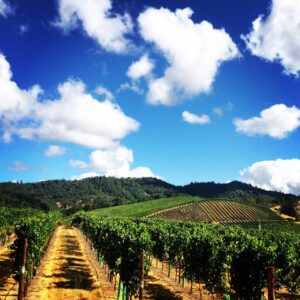The Umpqua Valley has a streak of wildness to it. Sparsely populated, its towns lie scattered amidst a series of rugged, undulating hills thatched in spikey Ponderosa pine and black oak. The Umpqua River and it’s winding tributaries churn and tumble through a network of valleys formed by the collision of three mountain ranges—the Klamath, the Coast Range, and the Cascades—before emptying into the Pacific Ocean. In the 1800s, prospectors dredged and panned sandbars of the South Umpqua and the Rogue rivers, in search of match head-sized nuggets of gold. It’s this dramatic history and landscape that colors the region, whose wines I’d never tasted despite fifteen years in the wine industry, most of them spent in the Pacific Northwest. As I would quickly learn on a pre-harvest junket in 2015, the wines from the emerging Southern Oregon AVA are as complex and surprising as the terrain itself.
On that cloudless mid-summer day, I found myself squinting into bright afternoon sunlight, listening to winemaker Earl Jones as he explained the significance of the Klamath-Coastal fault line that runs through his tidy south-facing vineyard blocks. Looking more like an archeologist than winegrower, clad in khakis and a weathered hat, Earl explained the rationale behind his risky decision to plant Spanish varieties in the Umpqua Valley.
“The story was—only Rioja could grow great Tempranillo. In 1972 Alejandro Fernández, founder of Tinto Pesquera, proved everyone wrong by cultivating Tempranillo in Ribero del Duero. Alejandro was convinced that climate was more important to the vines’ success than soil type, and it turned out that Ribero del Duero and the Rioja have similar macroclimates.” He continued, “I had a love for Tempranillo. So when I heard this story in 1986, I started thinking it could grow somewhere in the United States if I could find the right climate. I had enough sense to know that I needed soil with good drainage, and I wanted a hillside location. When we found this spot, I didn’t know it was sitting on a fault line. Having the right soil was total luck.”
Dubbed the “Hundred Valleys of the Umpqua,” the Jones’ property lies in the warmer Southern end of the AVA. Evergreens give way to rolling oak savannah, and the site lies within a rainshadow created by the Oregon Coastal Range and portions of the Klamath Mountains, well shielded from the marine air that cools the AVA at its Northernmost tip.

You can download a PDF of the full article or browse to read it online in The Somm Journal’s April-May 2017 edition.
